A novel points of interest selection method for svm - Based profiled attacks
Hiện nay, tấn công mẫu được xem là
một trong những tấn công kênh kề (SCA) mạnh.
Các thuật toán học máy, ví dụ như máy vector hỗ
trợ (SVM), thường được sử dụng để nâng cao
hiệu quả của tấn công mẫu. Một thách thức đối
với tấn công mẫu sử dụng SVM là cần phải tìm
được các điểm thích hợp (POI) hay các đặc trưng
từ vết điện năng tiêu thụ. Công trình nghiên cứu
này đề xuất một phương pháp mới đề tìm POI
của vết điện năng tiêu thụ bằng cách kết hợp kỹ
thuật phân tích mode biến phân (VMD) và quá
trình trực giao hóa Gram-Schmidt (GSO). Trong
đó, VMD được sử dụng để phân tách vết điện
năng tiêu thụ thành các tín hiệu con còn gọi là
VMD mode và việc lựa chọn POIs trên VMD
mode này được thực hiện dựa trên quá trình
GSO. Dựa trên phương pháp lựa chọn POIs này,
chúng tôi đề xuất phương pháp tấn công mẫu sử
dụng SVM có hiệu quả tốt hơn các tấn công mẫu
khác ở cùng kịch bản tấn công. Các thí nghiệm
tấn công được thực hiện trên tập dữ liệu được thu
thập từ thẻ thông minh Atmega8515 cài đặt AES-
128 chạy trên nền tảng thiết bị tấn công kênh kề
Sakura-G/W và tập dữ liệu DPA Contest v4, để
chứng minh tính hiệu quả của phương pháp của
chúng tôi, trong việc giảm số lượng vết điện năng
tiêu thụ cần cho cuộc tấn công, đặc biệt trong
trường hợp các điện năng tiêu thụ có nhiễu

Trang 1
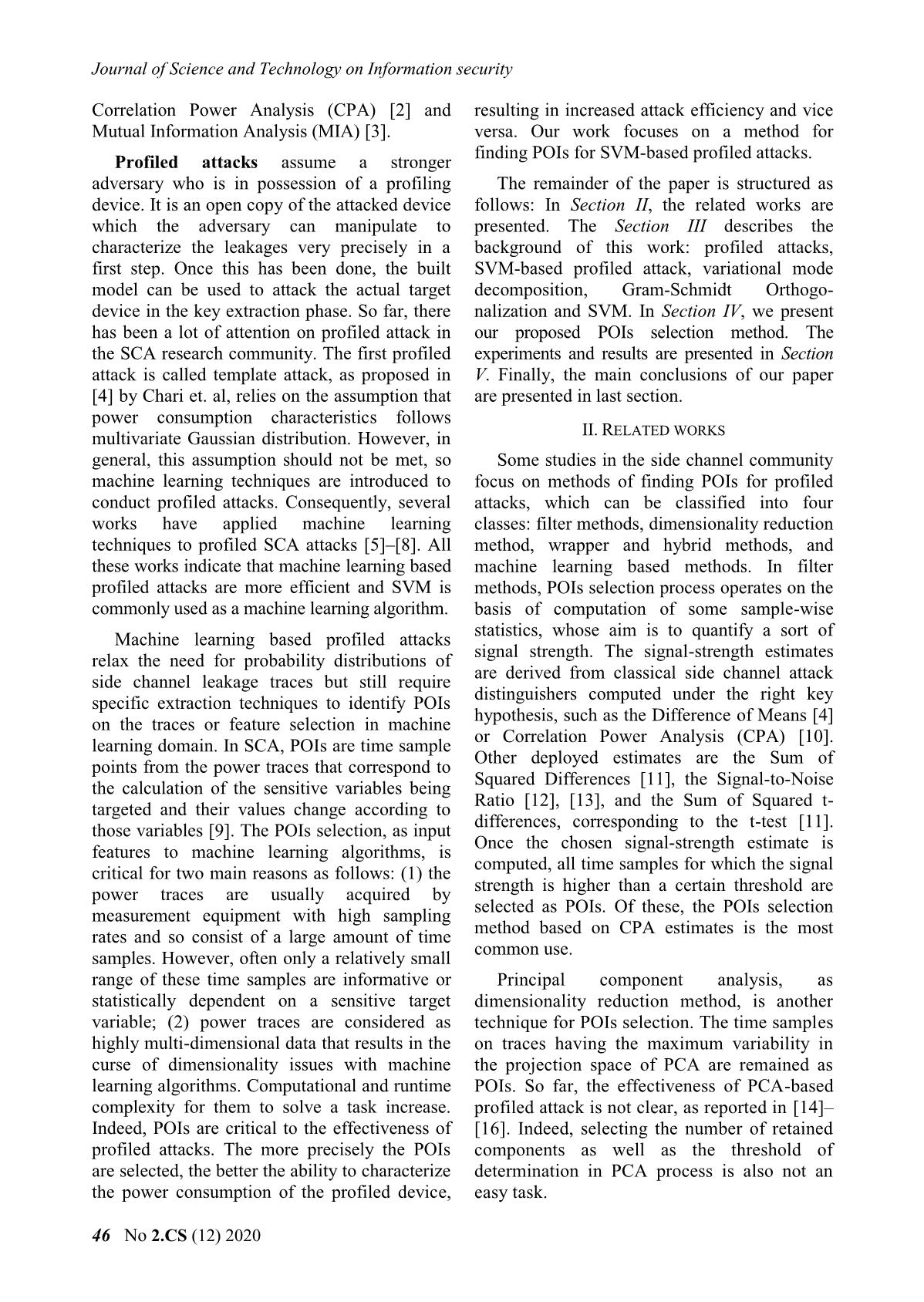
Trang 2
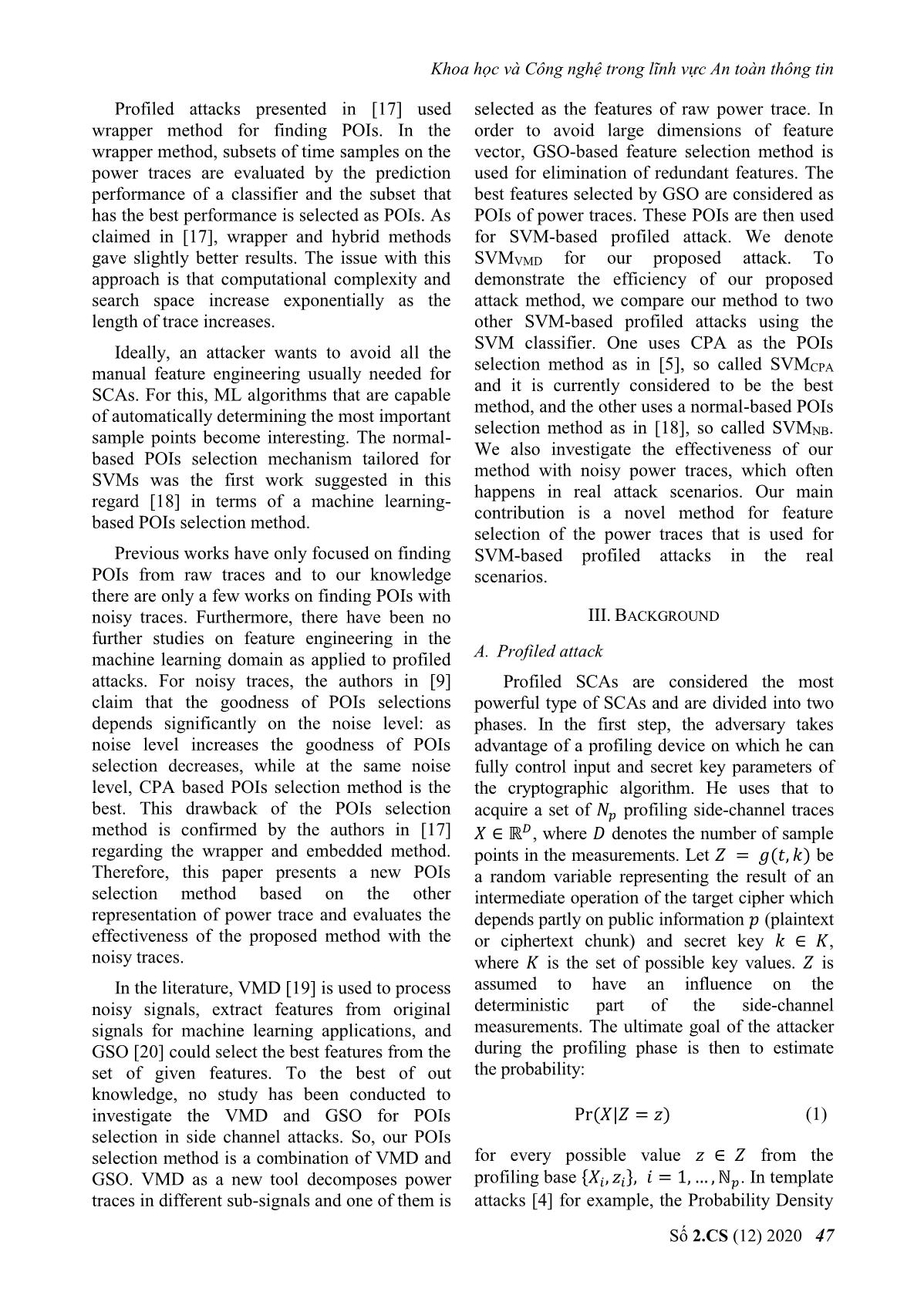
Trang 3

Trang 4

Trang 5
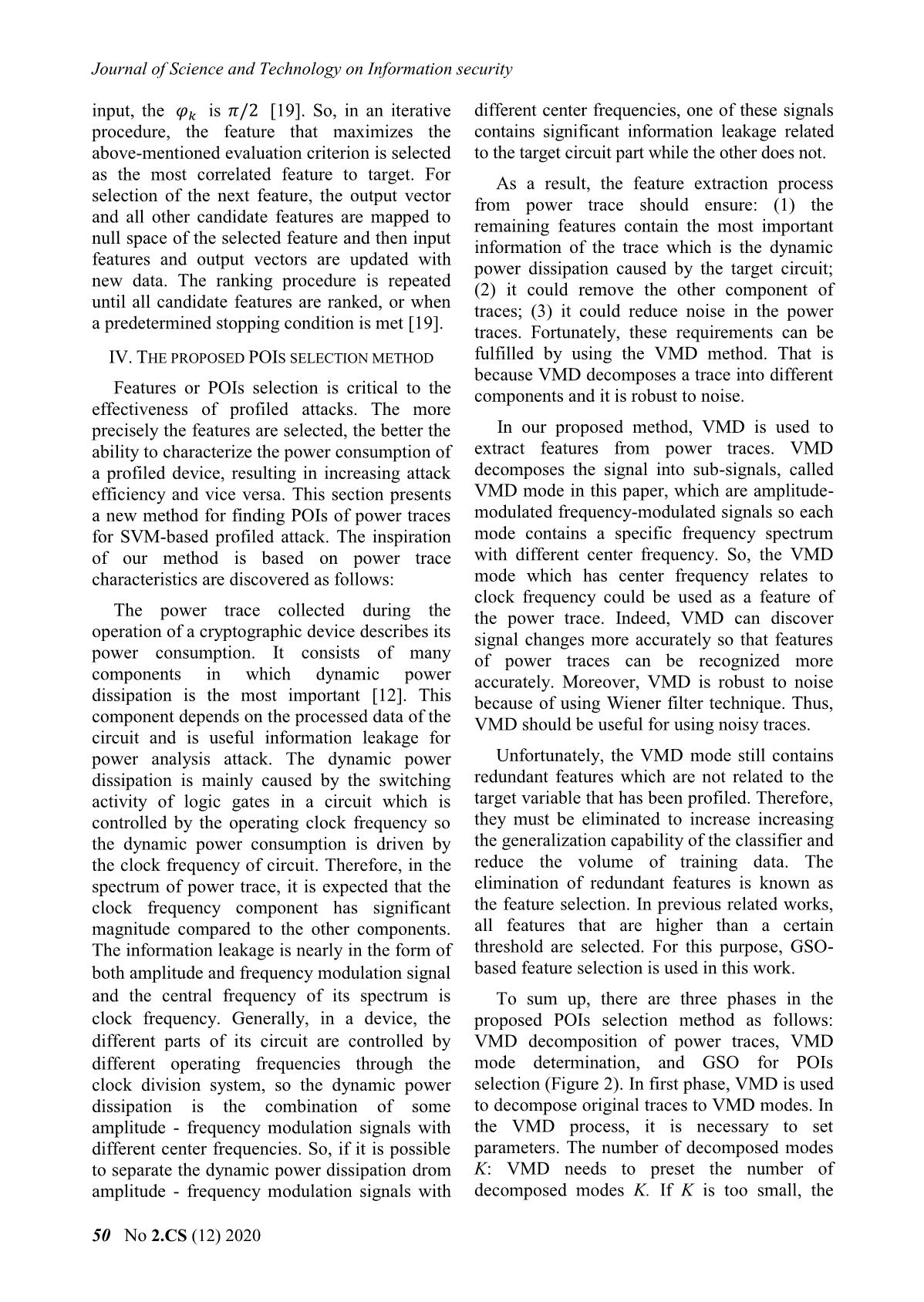
Trang 6
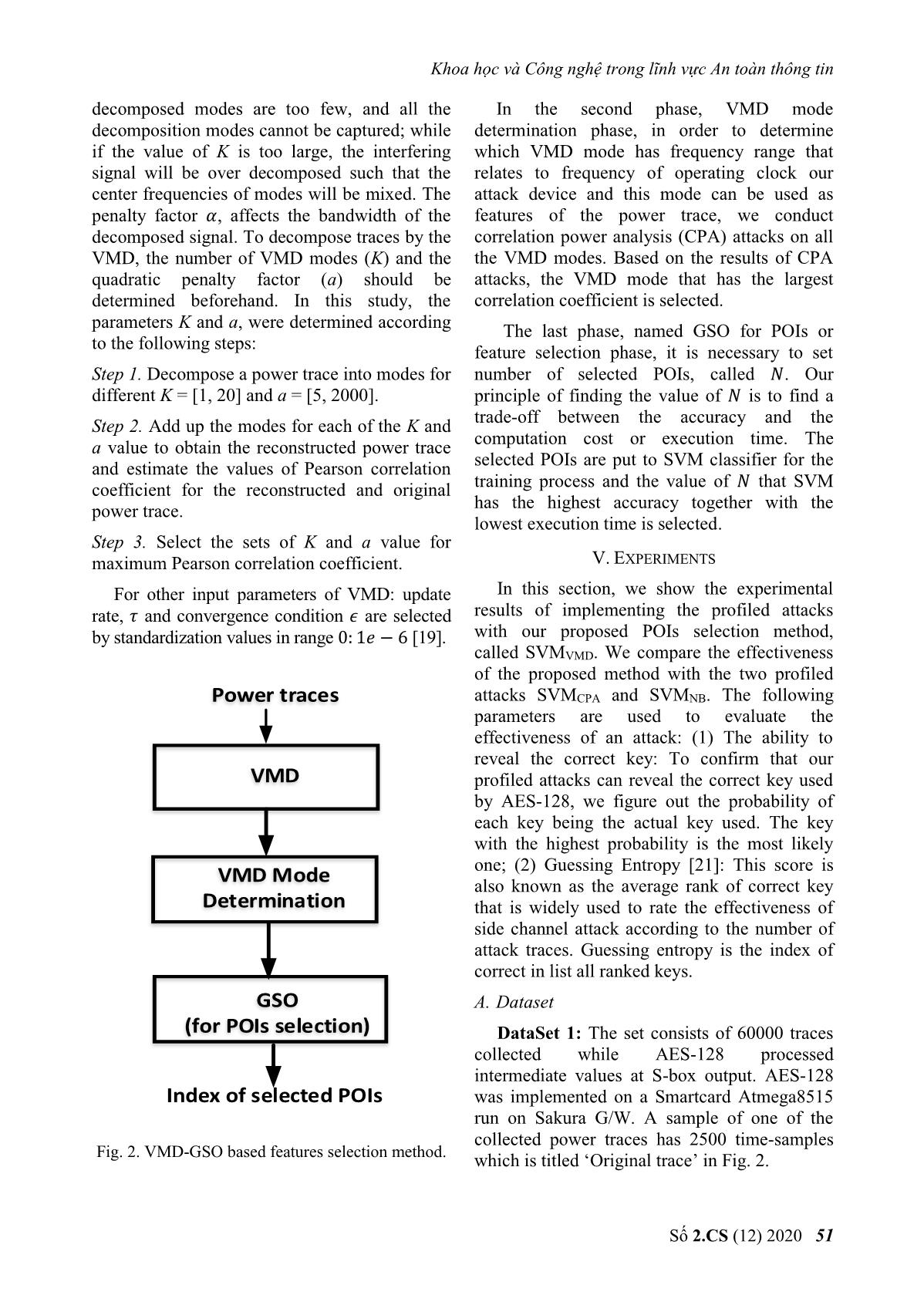
Trang 7
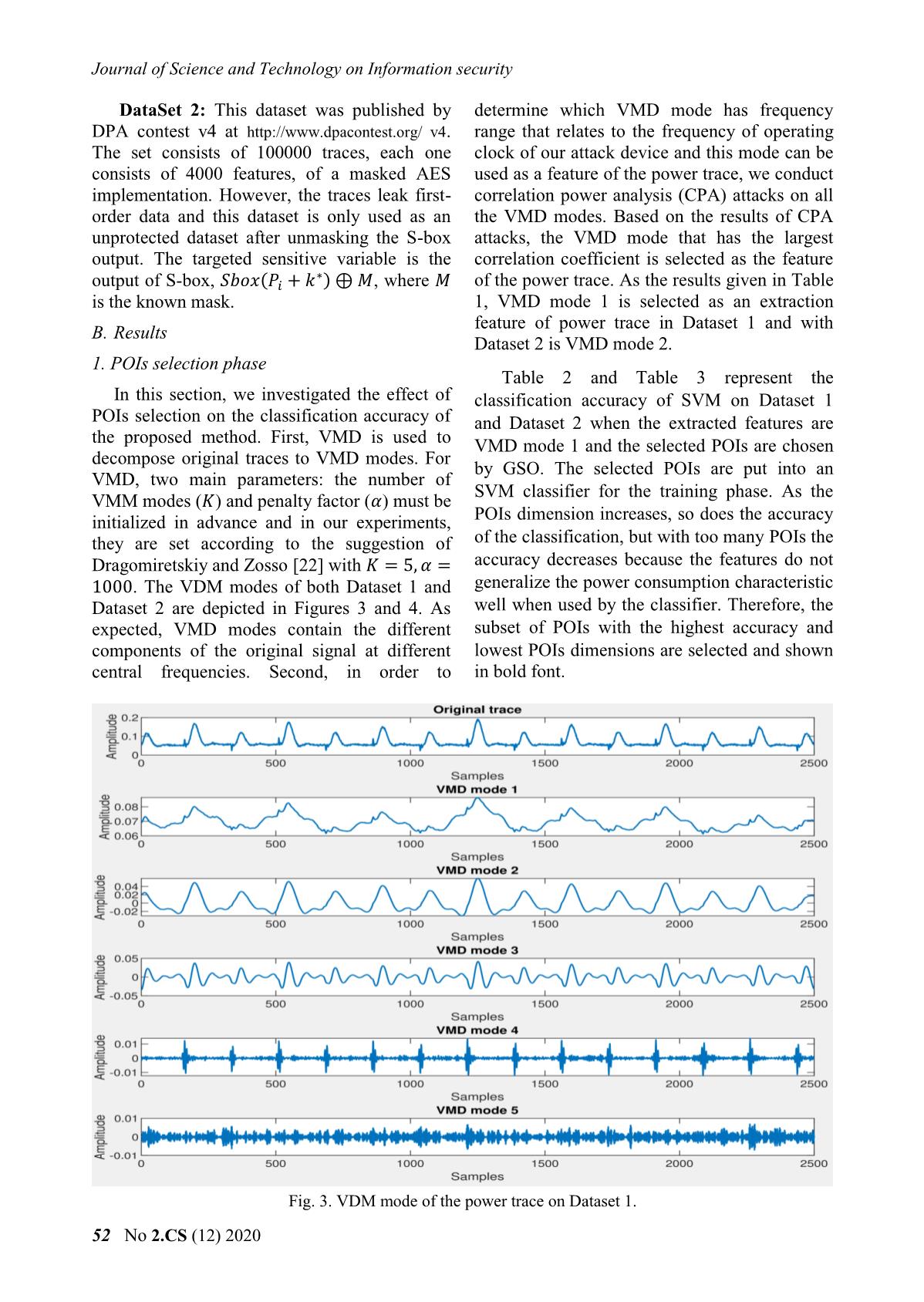
Trang 8
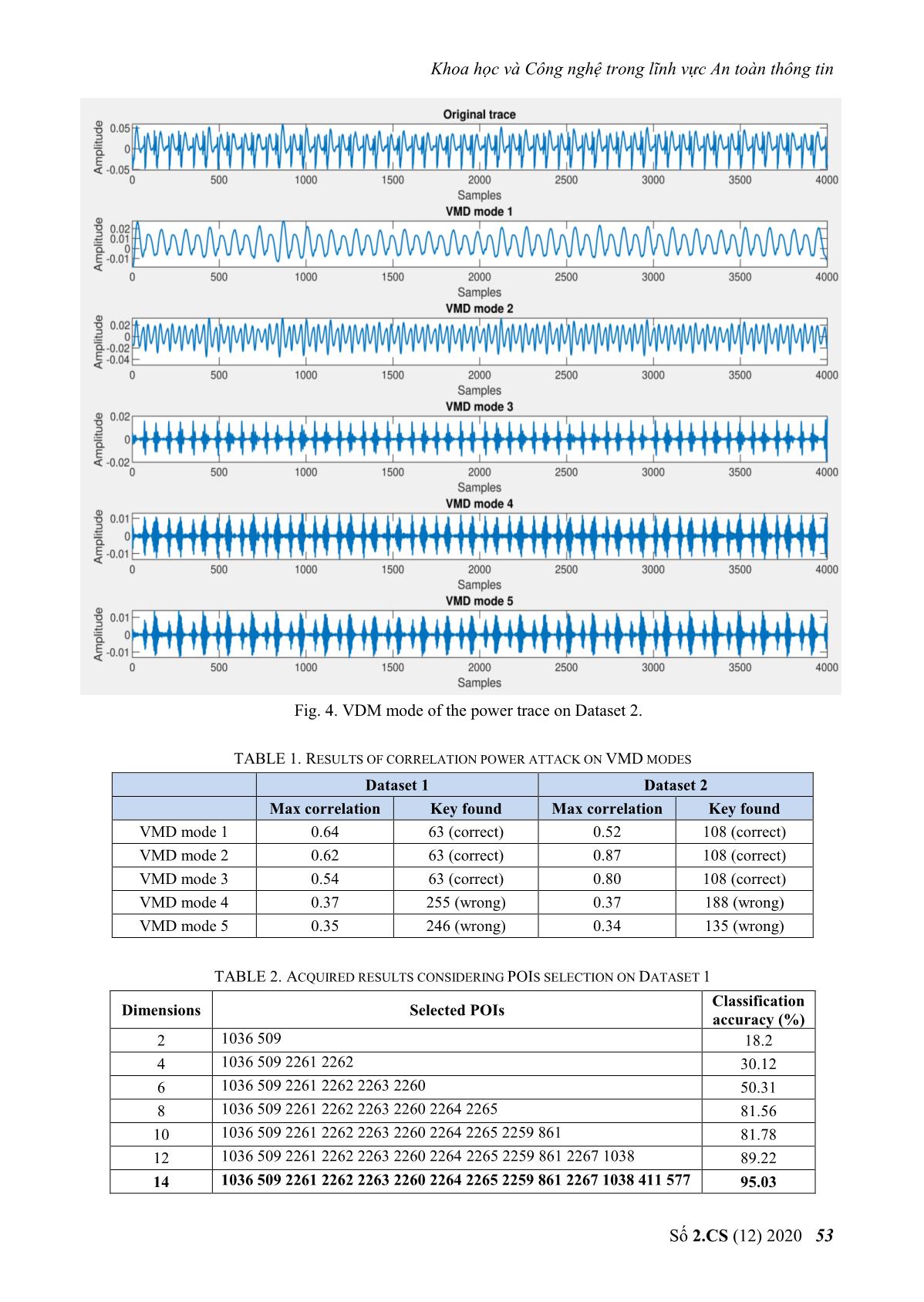
Trang 9
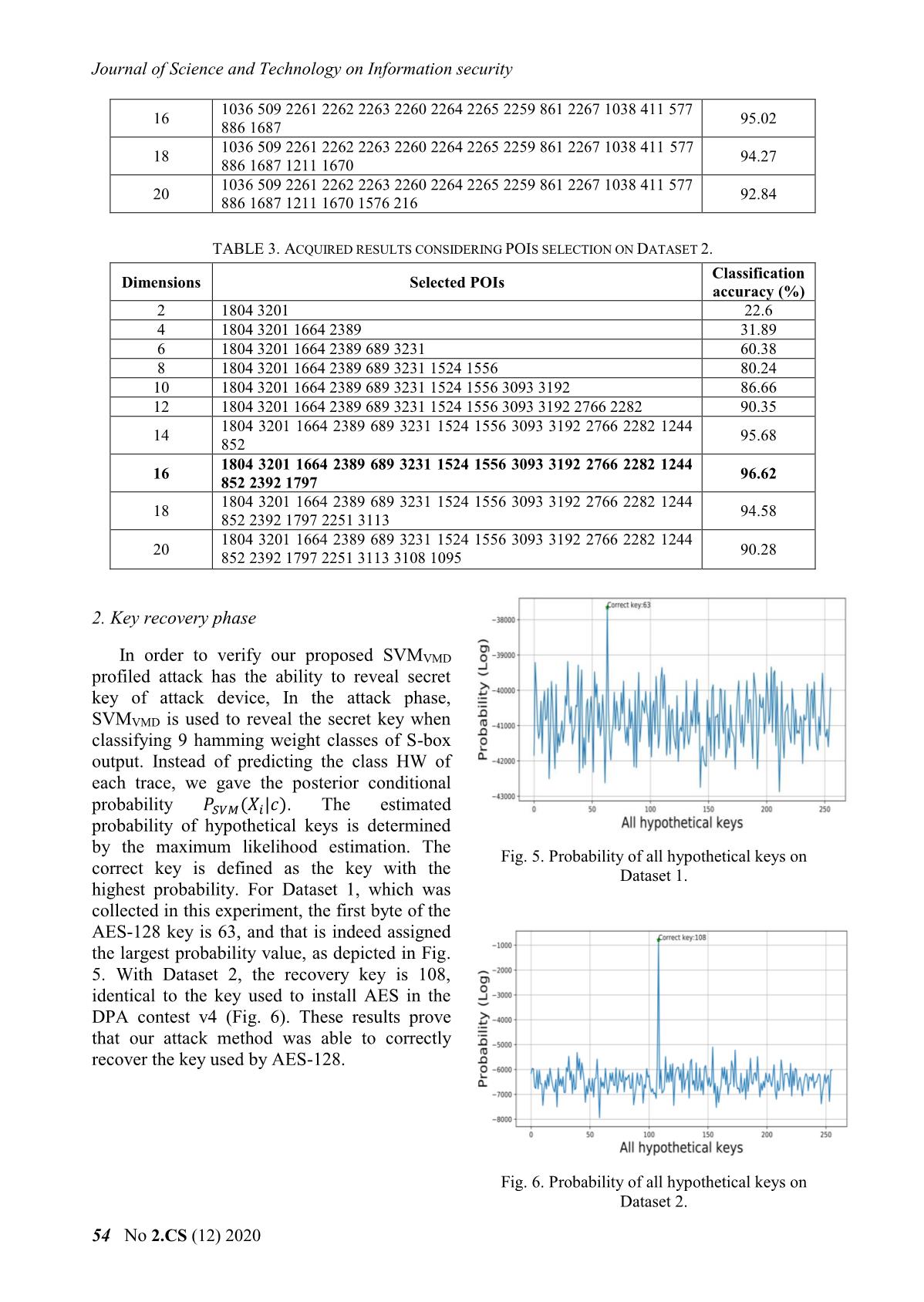
Trang 10
Tải về để xem bản đầy đủ
Tóm tắt nội dung tài liệu: A novel points of interest selection method for svm - Based profiled attacks
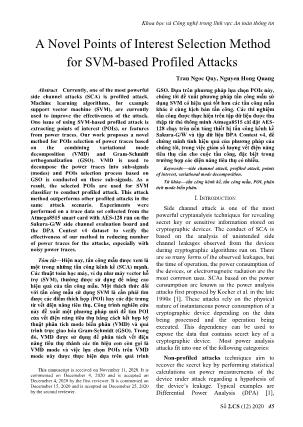
Khoa học và Công nghệ trong lĩnh vực An toàn thông tin Số 2.CS (12) 2020 45 Tran Ngoc Quy, Nguyen Hong Quang Abstract—Currently, one of the most powerful side channel attacks (SCA) is profiled attack. Machine learning algorithms, for example support vector machine (SVM), are currently used to improve the effectiveness of the attack. One issue of using SVM-based profiled attack is extracting points of interest (POIs), or features from power traces. Our work proposes a novel method for POIs selection of power traces based on the combining variational mode decomposition (VMD) and Gram-Schmidt orthogonalization (GSO). VMD is used to decompose the power traces into sub-signals (modes) and POIs selection process based on GSO is conducted on these sub-signals. As a result, the selected POIs are used for SVM classifier to conduct profiled attack. This attack method outperforms other profiled attacks in the same attack scenario. Experiments were performed on a trace data set collected from the Atmega8515 smart card with AES-128 run on the Sakura-G/W side channel evaluation board and the DPA Contest v4 dataset to verify the effectiveness of our method in reducing number of power traces for the attacks, especially with noisy power traces. Tóm tắt—Hiện nay, tấn công mẫu được xem là một trong những tấn công kênh kề (SCA) mạnh. Các thuật toán học máy, ví dụ như máy vector hỗ trợ (SVM), thường được sử dụng để nâng cao hiệu quả của tấn công mẫu. Một thách thức đối với tấn công mẫu sử dụng SVM là cần phải tìm được các điểm thích hợp (POI) hay các đặc trưng từ vết điện năng tiêu thụ. Công trình nghiên cứu này đề xuất một phương pháp mới đề tìm POI của vết điện năng tiêu thụ bằng cách kết hợp kỹ thuật phân tích mode biến phân (VMD) và quá trình trực giao hóa Gram-Schmidt (GSO). Trong đó, VMD được sử dụng để phân tách vết điện năng tiêu thụ thành các tín hiệu con còn gọi là VMD mode và việc lựa chọn POIs trên VMD mode này được thực hiện dựa trên quá trình This manuscript is received on November 11, 2020. It is commented on Decemeber 4, 2020 and is accepted on Decemeber 4, 2020 by the first reviewer. It is commented on Decemeber 15, 2020 and is accepted on Decemeber 25, 2020 by the second reviewer. GSO. Dựa trên phương pháp lựa chọn POIs này, chúng tôi đề xuất phương pháp tấn công mẫu sử dụng SVM có hiệu quả tốt hơn các tấn công mẫu khác ở cùng kịch bản tấn công. Các thí nghiệm tấn công được thực hiện trên tập dữ liệu được thu thập từ thẻ thông minh Atmega8515 cài đặt AES- 128 chạy trên nền tảng thiết bị tấn công kênh kề Sakura-G/W và tập dữ liệu DPA Contest v4, để chứng minh tính hiệu quả của phương pháp của chúng tôi, trong việc giảm số lượng vết điện năng tiêu thụ cần cho cuộc tấn công, đặc biệt trong trường hợp các điện năng tiêu thụ có nhiễu. Keywords—side channel attack, profiled attack, points of interest, variational mode decomposition. Từ khóa—tấn công kênh kề, tấn công mẫu, POI, phân tích mode biến phân. I. INTRODUCTION Side channel attack is one of the most powerful cryptanalysis techniques for revealing secret key or sensitive information stored on cryptographic devices. The conduct of SCA is based on the analysis of unintended side channel leakages observed from the devices during cryptographic algorithms run on. There are so many forms of the observed leakages, but the time of operation, the power consumption of the devices, or electromagnetic radiation are the most common uses. SCAs based on the power consumption are known as the power analysis attacks first proposed by Kocher et al. in the late 1990s [1]. These attacks rely on the physical nature of instantaneous power consumption of a cryptographic device depending on the data being processed and the operation being executed. This dependency can be used to expose the data that contains secret key of a cryptographic device. Most power analysis attacks fit into one of the following categories: Non-profiled attacks techniques aim to recover the secret key by performing statistical calculations on power measurements of the device under attack regarding a hypothesis of the device’s leakage. Typical examples are Differential Power Analysis (DPA) [1], A Novel Points of Interest Selection Method for SVM-based Profiled Attacks Journal of Science and Technology on Information security 46 No 2.CS (12) 2020 Correlation Power Analysis (CPA) [2] and Mutual Information Analysis (MIA) [3]. Profiled attacks assume a stronger adversary who is in possession of a profiling device. It is an open copy of the attacked device which the adversary can manipulate to characterize the leakages very precisely in a first step. Once this has been done, the built model can be used to attack the actual target device in the key extraction phase. So far, there has been a lot of attention on profiled attack in the SCA research community. The first profiled attack is called template attack, as proposed in [4] by Chari et. al, relies on the assumption that power consumption characteristics follows multivariate Gaussian distribution. However, in general, this assumption should not be met, so machine learning techniques are introduced to conduct profiled attacks. Consequently, several works have applied machine learning techniques to profiled SCA attacks [5]–[8]. All these works indicate that machine learning based profiled attacks are more efficient and SVM is commonly used as a machine learning algorithm. Machine learning based profiled attacks relax the need for probability distributions of side channel leakage traces but still require specific extraction techniques to identify POIs on the traces or feature selection in machine learning domain. In SCA, POIs are time sample points from the power traces that correspond to the c ... thông tin Số 2.CS (12) 2020 53 Fig. 4. VDM mode of the power trace on Dataset 2. TABLE 1. RESULTS OF CORRELATION POWER ATTACK ON VMD MODES Dataset 1 Dataset 2 Max correlation Key found Max correlation Key found VMD mode 1 0.64 63 (correct) 0.52 108 (correct) VMD mode 2 0.62 63 (correct) 0.87 108 (correct) VMD mode 3 0.54 63 (correct) 0.80 108 (correct) VMD mode 4 0.37 255 (wrong) 0.37 188 (wrong) VMD mode 5 0.35 246 (wrong) 0.34 135 (wrong) TABLE 2. ACQUIRED RESULTS CONSIDERING POIS SELECTION ON DATASET 1 Dimensions Selected POIs Classification accuracy (%) 2 1036 509 18.2 4 1036 509 2261 2262 30.12 6 1036 509 2261 2262 2263 2260 50.31 8 1036 509 2261 2262 2263 2260 2264 2265 81.56 10 1036 509 2261 2262 2263 2260 2264 2265 2259 861 81.78 12 1036 509 2261 2262 2263 2260 2264 2265 2259 861 2267 1038 89.22 14 1036 509 2261 2262 2263 2260 2264 2265 2259 861 2267 1038 411 577 95.03 Journal of Science and Technology on Information security 54 No 2.CS (12) 2020 16 1036 509 2261 2262 2263 2260 2264 2265 2259 861 2267 1038 411 577 886 1687 95.02 18 1036 509 2261 2262 2263 2260 2264 2265 2259 861 2267 1038 411 577 886 1687 1211 1670 94.27 20 1036 509 2261 2262 2263 2260 2264 2265 2259 861 2267 1038 411 577 886 1687 1211 1670 1576 216 92.84 TABLE 3. ACQUIRED RESULTS CONSIDERING POIS SELECTION ON DATASET 2. Dimensions Selected POIs Classification accuracy (%) 2 1804 3201 22.6 4 1804 3201 1664 2389 31.89 6 1804 3201 1664 2389 689 3231 60.38 8 1804 3201 1664 2389 689 3231 1524 1556 80.24 10 1804 3201 1664 2389 689 3231 1524 1556 3093 3192 86.66 12 1804 3201 1664 2389 689 3231 1524 1556 3093 3192 2766 2282 90.35 14 1804 3201 1664 2389 689 3231 1524 1556 3093 3192 2766 2282 1244 852 95.68 16 1804 3201 1664 2389 689 3231 1524 1556 3093 3192 2766 2282 1244 852 2392 1797 96.62 18 1804 3201 1664 2389 689 3231 1524 1556 3093 3192 2766 2282 1244 852 2392 1797 2251 3113 94.58 20 1804 3201 1664 2389 689 3231 1524 1556 3093 3192 2766 2282 1244 852 2392 1797 2251 3113 3108 1095 90.28 2. Key recovery phase In order to verify our proposed SVMVMD profiled attack has the ability to reveal secret key of attack device, In the attack phase, SVMVMD is used to reveal the secret key when classifying 9 hamming weight classes of S-box output. Instead of predicting the class HW of each trace, we gave the posterior conditional probability 𝑃𝑆𝑉𝑀(𝑋𝑖|𝑐). The estimated probability of hypothetical keys is determined by the maximum likelihood estimation. The correct key is defined as the key with the highest probability. For Dataset 1, which was collected in this experiment, the first byte of the AES-128 key is 63, and that is indeed assigned the largest probability value, as depicted in Fig. 5. With Dataset 2, the recovery key is 108, identical to the key used to install AES in the DPA contest v4 (Fig. 6). These results prove that our attack method was able to correctly recover the key used by AES-128. Fig. 5. Probability of all hypothetical keys on Dataset 1. Fig. 6. Probability of all hypothetical keys on Dataset 2. Khoa học và Công nghệ trong lĩnh vực An toàn thông tin Số 2.CS (12) 2020 55 Fig. 7 and Fig. 8 report the GE corresponding to different numbers of traces used for attacks with Dataset 1 when SVMVMD, SVMCPA and SVMNB are used to predict hamming weight classes. As expected, the GEs of all attacks decrease as the number of traces increases. Moreover, the larger the size of the training set, the lower the GE. The reason for this is that the performance of SVM is determined by its parameters, and the size of the training set is critical to finding the best parameters for the SVM. With Dataset 2, we performed the same experiments as for Dataset 1, and the GE calculated in the attack phases are presented in Figures 9 and 10. The overall performance of all the attacks is the same as those for Dataset 1. Again, SVMVMD achieves the best GE values. In Table 4, for each dataset we give the number of traces required by the profiled attacks based on SVM for guessing entropy to reach 0. SVMVMD requires the minimum number of traces to recover the key, 10.2 and 5.3 traces on average, corresponding to 100 and 200 profiling traces respectively. These empirical results indicate that the SVM-based profiled attack with our proposed POIs selection method is more effective than the attacks with the CPA and normal-based POI selection method. This can be explained by the combining of VMD and GSO for POI selection allowing more effective selection of trace characteristics than the CPA and normal-based POI selection methods. Fig. 7. Attack performance with 100 traces/HW class on Dataset 1. Fig. 8. Attack performance with 200 traces/HW class on Dataset 1. Fig. 9. Attack performance with 100 traces/HW class on Dataset 2. Fig. 10. Attack performance with 200 traces/HW class on Dataset 2. Journal of Science and Technology on Information security 56 No 2.CS (12) 2020 3. Results in the case of noisy traces Fig. 11. Attack results on Dataset 1 with 𝑆𝑁𝑅1 = 20 noise added to power traces. Fig. 12. Attack results on Dataset 1 with 𝑆𝑁𝑅2 = 10 noise added to power traces. Fig. 13. Attack results on Dataset 2 with 𝑆𝑁𝑅1 = 20 noise added to power traces. Fig. 14. Attack results on Dataset 2 with 𝑆𝑁𝑅2 = 10 noise added to power traces. The power traces are usually polluted with noise in practice. To examine the effectiveness of our proposed SVMVMD profiled attack in noisy condition, additive Gaussian noise is added to the power traces. In our experiments, two noise levels of standard deviation 𝑆𝑁𝑅1 = 20 and 𝑆𝑁𝑅2 = 10 are added to both Dataset 1 and Dataset 2. In addition, different feature extraction techniques were used for the SVM- based profiled attacks to investigate their effects on the efficiency of the attacks in the presence of noise. Overall, the guessing entropy of all the attacks increase with the level of noise, but the attack based on SVM with combining of VMD and GSO is the least sensitive to noise. The results of our attacks with 200 profiling traces per Hamming weight class, presented in Fig. 11, 12, 13 and 14 and Table 5, show that out of SVMCPA, SVMNB and SVMVMD, the proposed method, SVMVMD, has the best performance at both noise levels while SVMCPA and SVMNB are comparable to each other. After adding noise to the power trace, the number of traces required for GE to reach 0 increased by only 25% approximately with the proposed attack, while it increased by over 100% for the other methods. This proves that the VMD signal is insensitive to noise so the SVMVMD attack should work well under noisy conditions. This property is very useful in real attack scenarios where collected measurement traces invariably contain noise. Khoa học và Công nghệ trong lĩnh vực An toàn thông tin Số 2.CS (12) 2020 57 TABLE 4. NUMBER OF TRACES USED BY THE ATTACKS TO ATTAIN GE=0 Num. of. profiling traces Dataset 1 Dataset 2 SVMVMD SVMCPA SVMNB SVMVMD SVMCPA SVMNB 100 10.2 18.1 17.6 10.3 19.2 18.3 200 5.3 9.2 8.7 4.7 9.4 7.3 TABLE 5. NUMBER OF NOISY TRACES USED BY THE ATTACKS TO ATTAIN GE=0 Noise level Dataset 1 Dataset 2 SVMVMD SVMCPA SVMNB SVMVMD SVMCPA SVMNB 𝑆𝑁𝑅1 = 20 7.4 19.0 17.0 6.7 18.8 14.6 𝑆𝑁𝑅2 = 10 8.6 25.7 23.6 9.8 21.6 20.2 VI. CONCLUSION In this work, the combining of variational mode decomposition and Gram-Schmidt orthogonalization was proposed as a POIs selection method of power traces. The VMD mode that has central frequency related to clock operation frequency of the attack device can be used as features of power traces and GSO can be used as a POIs selection method. Experimental results show that an acceptable classification accuracy can be achieved when SVM classifier uses these selected features as its input. Compared to other SVM-based profiled attacks, the SVMVMD required the minimum number of traces for successful key recovery. Furthermore, SVMVMD is less sensitive to noise so can be used well with noisy power traces. In our opinion, this work suggests a new approach for feature extraction from power traces using variational mode decomposition, and this method should also be tested in combination with other feature selection methods and learning algorithms for profiled attacks. REFERENCES [1] Kocher P., Jaffe J., Jun B. “Differential Power Analysis”. In Proceedings of the 19th Annual International Cryptology Conference on Advances in Cryptology. London (UK), 1999, pp. 388–397. [2] Brier E., Clavier C., Olivier F. “Correlation Power Analysis with a Leakage Model”. In: Joye M., Quisquater JJ. (eds) Cryptographic Hardware and Embedded Systems - CHES 2004. CHES 2004. Lecture Notes in Computer Science, vol 3156. Springer, Berlin, Heidelberg. [3] Gierlichs B., Batina L., Tuyls P., Preneel B. “Mutual Information Analysis”. In: Oswald E., Rohatgi P. (eds) Cryptographic Hardware and Embedded Systems – CHES 2008. CHES 2008. Lecture Notes in Computer Science, vol 5154. Springer, Berlin, Heidelberg. [4] Chari S., Rao J.R., Rohatgi P. “Template Attacks”. In: Kaliski B.S., Koç .K., Paar C. (eds) Cryptographic Hardware and Embedded Systems - CHES 2002. CHES 2002. Lecture Notes in Computer Science, vol 2523. Springer, Berlin, Heidelberg. [5] Heuser A., Zohner M. “Intelligent Machine Homicide.” In: Schindler W., Huss S.A. (eds) Constructive Side-Channel Analysis and Secure Design. COSADE 2012. Lecture Notes in Computer Science, vol 7275. Springer, Berlin, Heidelberg. [6] Hospodar, G., Gierlichs, B., De Mulder, E. et al. “Machine learning in side-channel analysis: a first study.” J Cryptogr Eng 1, 293. 2011. [7] Hospodar, G., De Mulder, E., Gierlichs, B., Vandewalle, J., Verbauwhede, I. “Least Squares Support Vector Machines for Side- Channel Analysis”. In: COSADE 2011. CASED, Darmstadt. [8] S. Picek et al. “Side-channel analysis and machine learning: A practical perspective”. 2017 International Joint Conference on Neural Networks (IJCNN), Anchorage, AK, 2017, pp. 4095-4102. [9] Zheng, Y., Zhou, Y., Yu, Z., Hu, C., Zhang, H. "How to compare selections of points of interest for side-channel distinguishers in practice?" Information and Communications Security: 16th International Conference, ICICS 2014, Hong Kong, China. Journal of Science and Technology on Information security 58 No 2.CS (12) 2020 [10] Rechberger C., Oswald E. "Practical Template Attacks." Information Security Applications. WISA 2004. [11] Gierlichs B., Lemke-Rust K., Paar C. "Templates vs. Stochastic Methods". In Goubin L., Matsui M. (eds) Cryptographic Hardware and Embedded Systems - CHES 2006. Lecture Notes in Computer Science, vol 4249, Springer, Berlin, Heidelberg, 2006, pp. 15-29. [12] Stefan Mangard, Elisabeth Oswald, and Thomas Popp. “Power Analysis Attacks:Revealing the Secrets of Smart Cards”. Springer US, 2007. [13] Lomné V., Prouff E., Roche T. "Behind the Scene of Side Channel Attacks". In Sako K., Sarkar P. (eds) Advances in Cryptology - ASIACRYPT 2013. ASIACRYPT 2013. Lecture Notes in Computer Science, vol 8269, Springer, Berlin, Heidelberg, 2013, pp. 506-525. [14] Lerman, L., Bontempi, G., Markowitch, O. "Side channel attack: an approach based on machine learning". In COSADE 2011 - Second International Workshop on Constructive Side-Channel, 2011. [15] Liu, J., Zhou, Y., Han, Y., Li, J., Yang, S., Feng, D. "How to characterize side-channel leakages more accurately?". In ISPEC 2011 - Information Security Practice and Experience:7th International Conference, Guangzhou, China, 2011. [16] Houssem Maghrebi, Thibault Portigliatti, and Emmanuel Prouff. "Breaking cryptographic implementations using deep learning techniques". In Claude Carlet, M. Anwar Hasan, and Vishal Saraswat, editors, Security, Privacy, and Applied Cryptography Engineering, Springer International Publishing. ISBN 978-3-319-49445-6, 2016, pp. 3-26. [17] Picek, S., Heuser, A., Jovic, A., Legay, A. "On the relevance of feature selection for profiled side-channel attacks". Cryptology ePrint Archive, Report 2017/1110, https://eprint.iacr.org/2017/, 2017. [18] Bartkewitz, T., Lemke-Rust, K. "Efficient template attacks based on probabilistic multi- class support vector machines". In Mangard, S. (ed.) Smart Card Research and Advanced Applications:11th International Conference, CARDIS 2012, Graz, Austria, 2012. [19] Dragomiretskiy K and Zosso D. "Variational Mode Decomposition". IEEE Transactions on Signal, vol. 62, pp. 513-544, 2014. [20] H. Stoppiglia, G. Dreyfus, R. Dubois, Y. Oussar. "Ranking a random feature for variable and feature selection". J. Mach. Learn, vol. 3, pp. 1399-1414, 2003. [21] Standaert FX., Malkin T.G., Yung M. "A Unified Framework for the Analysis of Side- Channel Key Recovery Attacks". In In: Joux A. (eds) Advances in Cryptology - EUROCRYPT 2009. EUROCRYPT 2009. Lecture Notes in Computer Science, vol 5479, Springer, Berlin, Heidelberg, 2009. ABOUT THE AUTHORS Tran Ngoc Quy Workplace: Academy of Cryptography Techniques Email: quyhvm@gmail.com Education: Master’s degree in Electronic and Communication Techniques. Recent research direction: hardware attack, side channel attack, IoT security. Nguyen Hong Quang Workplace: Academy of Cryptography Techniques Email: quangnh@actvn.edu.vn Education: Received Master’s degree in 2003 and Assoc. Professor title in 2016. Recent research direction: cryptographic design, side channel attack, hardware security.
File đính kèm:
 a_novel_points_of_interest_selection_method_for_svm_based_pr.pdf
a_novel_points_of_interest_selection_method_for_svm_based_pr.pdf

